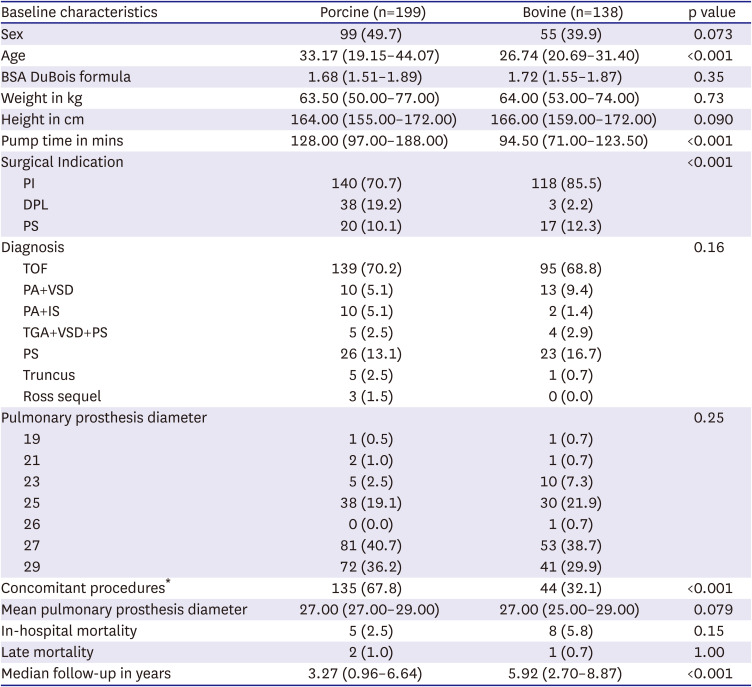1. Kogon BE, Rosenblum JM, Mori M. Current readings: issues surrounding pulmonary valve replacement in repaired tetralogy of fallot. Semin Thorac Cardiovasc Surg. 2015; 27:57–64. PMID:
26074110.

2. Fiore AC, Rodefeld M, Turrentine M, et al. Pulmonary valve replacement: a comparison of three biological valves. Ann Thorac Surg. 2008; 85:1712–1718. PMID:
18442571.

3. Emani SM. Options for prosthetic pulmonary valve replacement. Semin Thorac Cardiovasc Surg Pediatr Card Surg Annu. 2012; 15:34–37. PMID:
22424506.

4. Akins CW, Miller DC, Turina MI, et al. Guidelines for reporting mortality and morbidity after cardiac valve interventions. J Thorac Cardiovasc Surg. 2008; 135:732–738. PMID:
18374749.

5. Bermudez CA, Dearani JA, Puga FJ, et al. Late results of the peel operation for replacement of failing extracardiac conduits. Ann Thorac Surg. 2004; 77:881–887. PMID:
14992892.

6. Garrido MM, Kelley AS, Paris J, et al. Methods for constructing and assessing propensity scores. Health Serv Res. 2014; 49:1701–1720. PMID:
24779867.

7. Austin PC. The use of propensity score methods with survival or time-to-event outcomes: reporting measures of effect similar to those used in randomized experiments. Stat Med. 2014; 33:1242–1258. PMID:
24122911.

8. Koziarz A, Makhdoum A, Butany J, Ouzounian M, Chung J. Modes of bioprosthetic valve failure: a narrative review. Curr Opin Cardiol. 2020; 35:123–132. PMID:
31972604.

9. Kostyunin AE, Yuzhalin AE, Rezvova MA, Ovcharenko EA, Glushkova TV, Kutikhin AG. Degeneration of bioprosthetic heart valves: update 2020. J Am Heart Assoc. 2020; 9:e018506. PMID:
32954917.

10. Salaun E, Mahjoub H, Girerd N, et al. Rate, timing, correlates, and outcomes of hemodynamic valve deterioration after bioprosthetic surgical aortic valve replacement. Circulation. 2018; 138:971–985. PMID:
30354532.

11. Barakat A, Mittal A, Ricketts D, Rogers BA. Understanding survival analysis: actuarial life tables and the Kaplan-Meier plot. Br J Hosp Med (Lond). 2019; 80:642–646. PMID:
31707885.

12. Cuerpo Caballero G, López Menéndez J, Polo López L, et al. Cirugía cardiovascular en España en el año 2019. Registro de intervenciones de la Sociedad Española de Cirugía Cardiovascular y Endovascular. Cirugía Cardiovasc. 2021; 28:162–176.

13. Raghav V, Okafor I, Quach M, Dang L, Marquez S, Yoganathan AP. Long-term durability of Carpentier-Edwards magna ease valve: a one billion cycle in vitro study. Ann Thorac Surg. 2016; 101:1759–1765. PMID:
26806168.

14. Forcillo J, Pellerin M, Perrault LP, et al. Carpentier-Edwards pericardial valve in the aortic position: 25-years experience. Ann Thorac Surg. 2013; 96:486–493. PMID:
23684486.

15. Pragt H, van Melle JP, Verkerke GJ, Mariani MA, Ebels T. Pulmonary versus aortic pressure behavior of a bovine pericardial valve. J Thorac Cardiovasc Surg. 2020; 159:1051–1059.e1. PMID:
31383558.

16. Kwak JG, Bang JH, Cho S, et al. Long-term durability of bioprosthetic valves in pulmonary position: pericardial versus porcine valves. J Thorac Cardiovasc Surg. 2020; 160:476–484. PMID:
32014323.

17. Pragt H, Schoots MH, Accord RE, et al. A stented bovine pericardial prosthesis in the pulmonary position. J Thorac Cardiovasc Surg. 2020; 159:1063–1071.e1. PMID:
31400815.

18. Abbas JR, Hoschtitzky JA. Which is the best tissue valve used in the pulmonary position, late after previous repair of tetralogy of fallot? Interact Cardiovasc Thorac Surg. 2013; 17:854–860. PMID:
23929900.

19. Dorobantu DM, Sharabiani MT, Taliotis D, et al. Age over 35 years is associated with increased mortality after pulmonary valve replacement in repaired tetralogy of Fallot: results from the UK National Congenital Heart Disease Audit database. Eur J Cardiothorac Surg. 2020; 58:825–831. PMID:
32187367.

20. Aroca Á, Polo L, Pérez-Farinós N, et al. ¿Funcionan igual las prótesis pulmonares porcinas en menores de edad que en adultos? Una llamada a la prudencia. Cirugía Cardiovasc. 2017; 24:135–141.

21. Marathe SP, Bell D, Betts K, et al. Homografts versus stentless bioprosthetic valves in the pulmonary position: a multicentre propensity-matched comparison in patients younger than 20 years. Eur J Cardiothorac Surg. 2019; 2019:1–8.

22. Tatewaki H, Shiose A. Pulmonary valve replacement after repaired tetralogy of fallot. Gen Thorac Cardiovasc Surg. 2018; 66:509–515. PMID:
29779123.

23. Nomoto R, Sleeper LA, Borisuk MJ, et al. Outcome and performance of bioprosthetic pulmonary valve replacement in patients with congenital heart disease. J Thorac Cardiovasc Surg. 2016; 152:1333–1342.e3. PMID:
27637422.

24. Bortolotti U, Milano AD, Valente M, Thiene G. The stented porcine bioprosthesis: a 50-year journey through hopes and realities. Ann Thorac Surg. 2019; 108:304–308. PMID:
30959018.




